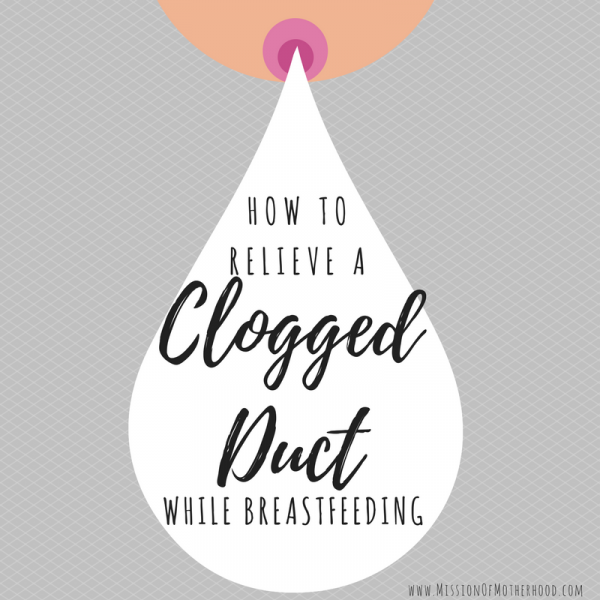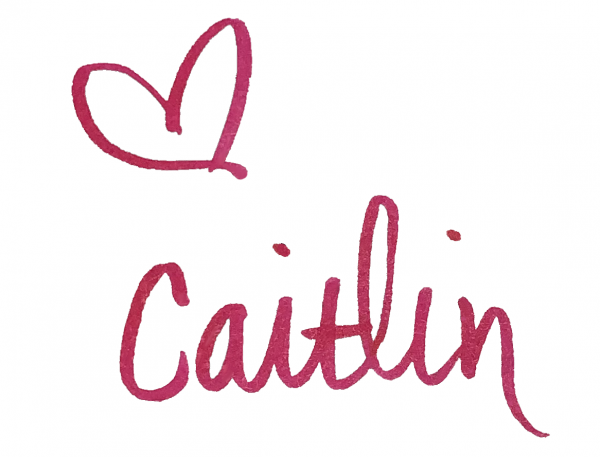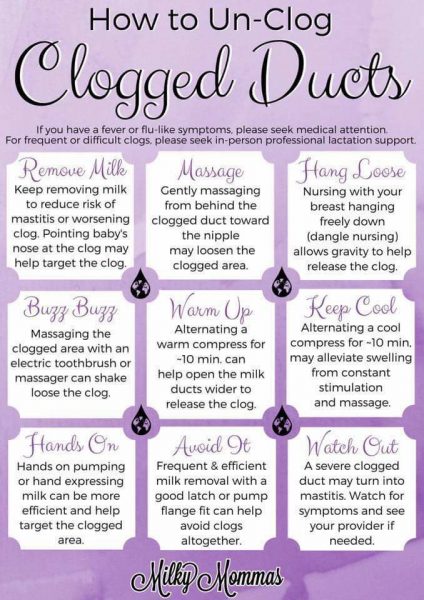This post may contain affiliate links. View my Disclosures page for more information.
I am not a doctor, a nurse, a midwife, or a lactation consultant — but I’ve been breastfeeding for 30+ consecutive months so I’m becoming something of an expert in my own right. It hasn’t always been easy, and I’ve learned quite a bit along the journey. Among other things, I’ve got some experience in the area of removing and relieving clogs while breastfeeding or pumping. I’ve included links to the products I’ve used myself for your convenience. Nurse on!

By and large (ha!), your breast size generally has nothing to do with your ability to breastfeed your baby. Sometimes augmentation or reduction surgery can, but as far as natural breast size, what you’ve got is good enough for your baby. However, I found that being busty for my size made (makes!) finding a properly supportive and well-fitting bra extremely hard to find. If you’ve breastfed for any length of time, you’ll know (or at least you can imagine) that an ill-fitting bra can make an already tough task supremely uncomfortable. In addition to having large breasts for my small frame, I also have hyperlactation, so my breasts feel constantly full. All of this together meant I was (am) quite prone to clogged ducts.
A clogged duct is a painful, hard, tender spot on the breast where milk stasis (improper milk removal) has caused the duct in the breast to become clogged. It often feels like a bruise, and can be located anywhere in the breast tissue, nipple, or under the arm. Once a clog dislodges, it may look gooey, stringy, or clumpy. They are completely safe to feed the baby (if she were nursing and dislodged it, you’d never know). You may also notice a spray of milk or forceful letdown as milk that’s been backed up releases. These are weird, but totally normal.
Having been down this road many times (and getting mastitis twice as a result), here are my tried and true recommendations for relieving those pesky (and painful!) clogged ducts — along with some additional resources.
Keep Breastfeeding
The temptation to stop nursing or decrease milk expression because of tenderness might come on, but don’t stop. Moving milk (nursing, pumping, or hand expressing) is the best way to clear a clog and prevent infection. Keep nursing!
Breast anatomy (ill-fitting bras), the baby’s latch, and lifestyle (pressure points created by clothing, straps, etc), can all make certain women more prone to clogs or suffer from recurrent clogged ducts. Clogs can also happen as baby weans, extends time between feedings, or if mom is away from the nursling for an extended period of time.
It’s not uncommon to feel residual pain or tenderness after the clog releases. Most women notice immediate relief followed by a hint of tenderness for a day.
Check Latch
Be sure baby’s latch is efficient, deep, and effective. An improper latch can cause pain, let alone cracked nipples which can be a point of entry for infection. An inefficient latch can impede proper milk removal, thus leading to clogged ducts.
Take 2 lecithin right away (1200mg) and 2 before bed, then 4/day (spacing them out over the day is more effective but you can take all 4 at once): up to 4800mg/day (4 pills). Lecithin comes in soy and sunflower varieties, and is completely safe to nurse with. Lecithin is an emulsifier that helps break up fat clumps.
Don’t just stop! Once the clog dislodges, taper down by taking 1 less pill over the course of a few days (should take a week or so to taper off completely). Some people, myself included, have to take 1-2 lecithin daily for the duration of the breastfeeding journey to prevent clogs from returning.
You should try an Epsom salt soak with breast compressions/massage before nursing the baby. Rinse off your nipple before latching since it could make the initial latch taste funny to the baby at first! Epsom salts can help draw out clogs and infection. Hand expressing into a bowl of warm water with Epsom salts in it is extremely effective for moving milk.
“Dangle” feeding is an effective way of dislodging a clog. To dangle nurse, line the baby’s nose or chin up with the clog, nurse on all fours leaning over the baby. Offer affected side first while massaging above the clog toward the nipple. It will be tender, but gravity and massage work together!
You can also dangle massage in an Epsom salt soak in a bowl. Use the warmest water you can stand, follow the instructions on the bag for the ratio of water to salts, and massage from above the clog down toward the nipple. A wide toothed comb with some soap or an electric toothbrush/personal massager can work better than just fingers to shake loose a clog.
If you can’t nurse and have to pump, dangle pumping or dangle hand-expressing (especially after an Epsom salt soak) combined with the lecithin and vibration massage can be almost as effective. Moving milk is the best cure for a clog. Anything you express or pump is completely safe to feed the baby. If she were nursing, you wouldn’t even know. I say this because sometimes clogs can look like a string of spaghetti or a small glob when it comes out in the pump or bowl while you’re expressing.
If the baby is nursing when a clog dislodges, you might notice a sudden sputtering because of the flow change. Sometimes it sprays like crazy! Keep moving the milk! If the baby is unhappy at the sudden spray, hand express over a towel or into a bowl or cup. You can freeze it for later!
Heat
A warm compress, warm bath, or heating pad can help. I recently discovered these Lansinoh TheraPearls, and they are muy bueno. If you don’t have a heating pad or TheraPearls, one of my favorite tricks is to wet a fresh newborn disposable diaper with some clean water and microwave it for 15-30 second increments until it is extremely warm (but not so hot that it will burn you). They fit well on most breasts, you can tuck them inside your bra or shirt if you need to, and they can relieve pain from clogs, mastitis, and engorgement. You can do the same with some of the disposable nursing pads as well.
Taking 600-800 mg every 6-8 hours. It helps with pain, inflammation, and a fever if you get one. Ibuprofen is safe to nurse with. Even after a clog dislodges, I find I have to take ibuprofen again because of residual pain or inflammation from where the clog WAS.
According to the NIH, probiotics are defined as live micro-organisms, which when administered in adequate amounts, confer health benefits on the host. Taking probiotics can help prevent mastitis, heal mastitis, and if you end up on an antibiotic, can help counteract the negative effects an antibiotic can have on your gut (upset stomach, diarrhea, or yeast). Look for a probiotic with Lactobacillus salivarius and Lactobacillus fermentum, as these strains in particular were the ones most effective in the study presented by the NIH.
You can find probiotics at your local health food or nutrition store, pharmacy, or Amazon. Probiotics are safe to nurse with, and many live cultures are found in yogurt, cottage cheese, or other fermented foods.
Know your body. Mastitis is a painful, annoying, and extremely inconvenient bacterial infection of the breast and is often caused by a clogged duct that wasn’t properly expressed. It comes on QUICKLY, sometimes within an hour and without notice (my second time, I was tandem nursing 2 kids, and thought I knew everything about breastfeeding. I had no clogged duct that I knew of, but I caught it early, thankfully.)
Look at your breasts often. Watch for red spots, pink lines or streaking, which can indicate an infection and the need for antibiotics to stop and cure mastitis. Call your OB, midwife, or general practitioner right away if you see signs of infection or suspect mastitis. A lactation consultant can help diagnose it, but a provider will need to call in the medication for you.
The second time I got mastitis I had a very tender spot on my breast, and called the midwife when I felt feverish even though I had not yet seen signs of streaking (that appeared a full 24 hours later). Knowing your body and trusting your gut instincts is incredibly valuable.
Continue taking the ibuprofen and lecithin even if you get an antibiotic for mastitis. Don’t play around with mastitis even if you don’t like antibiotics. (It can lead to an abscess and that’s miserable). Oral antibiotics may take up to 24 hours to take effect, which is why it is important not to wait to call when you suspect mastitis. The gold standard for mastitis is 500mg of dicloxacillin 4x a day. Another acceptable antibiotic is 500mg of cephalexin 4x a day.
Once you get mastitis, because of ductal scarring, you are more at risk for developing it again later. It is extremely common in the US within the first few weeks of breastfeeding, but can happen at any time. In cultures where breastfeeding is more mainstream and accepted, mastitis is more rare. The best way to cure and prevent mastitis is feeding often and on demand, with a good latch.
Abscess
If a clog doesn’t clear in a few days, it could be an abscess. A midwife, OB/Gyn, IBCLC (lactation consultant), or other breast specialist can do an ultrasound or diagnose it and potentially help drain the abscess. There are places here who do diagnostic and therapeutic ultrasounds (which can help move the clog with ultrasound) but I don’t know about where you live. Your IBCLC or OB provider can probably refer you for physiotherapy if such a method is recommended.
Make sure you have a properly fitting bra. I cannot stress this enough. You will be SHOCKED how many of us are wearing the wrong size bra. This can be a life-changer, and can make ALL the difference in sustained comfort over the course of your breastfeeding journey. Read the fitting guide above and measure yourself before you order one!
Good, supportive bras can be expensive, but many are available for cheaper, or at least with free returns, on Amazon. Even if not, they are SO worth it — even if you can only afford one good one. Wash by hand, and air dry each night. You will not regret it.
Supply
You may notice a dip in supply as you recover from a clog (because a duct was BLOCKED) and then a boost in supply as the demand to move milk kicks in. A daily dose of 1-2 lecithin for a few weeks can help (I had to take one daily for months to keep clogs at bay). Most people, however, don’t need to worry about supply, so don’t let that get you down. (Pump output is not a good indicator of your milk supply, anyway.)
Some babies don’t like the taste of milk clogs or may seem frustrated because the milk doesn’t come out as fast because of a clog, but keep trying. Nursing clears it out better than anything, even pumping. Yes, I know I’ve already said these things, but I can’t stress it enough: keep nursing.
What Medications and Supplements are Safe to Take while Breastfeeding?
The human body is an amazing filter, and breastmilk is hardy and resilient. Many providers, however, may recommend “pumping and dumping” as a way to cover themselves without having to do research. Have no fear! The Texas Tech University Health Sciences Center has already done the research! This is good news.
They have an app as well, but you can access their Infant Risk Center database here. Their list is comprehensive and extremely informative. You can also call them between 8am-5pm central time Monday-Friday and speak with a live person. I have utilized this resource a number of times, and even been able to educate a few providers.
Other Resources
Knowledge is power. In addition to the information above, here are some other helpful resources for relieving (or diagnosing!) clogged ducts while breastfeeding, and more tips on how to prevent mastitis or an abscess.
https://kellymom.com/store/handouts/concerns/mastitis-tips.pdf
http://www.llli.org/nb/nbmarapr07p76.html
Nurse on!




thank you for this!! very informative while some of the tips i have tried and were successful. like you, been experiencing recurrent clogged ducts and still looking for more tips to ease pain or at least avoid it. im new to breastfeeding (6 months and counting) have no plan on pursuing it til the 3rd month but i am amazed im still at it beyond 3months. maybe because its so so worth it. my eldest is a formula-fed baby and ive seen the difference between my 2 lovelies. . will try epsom salt soak bath and massager.